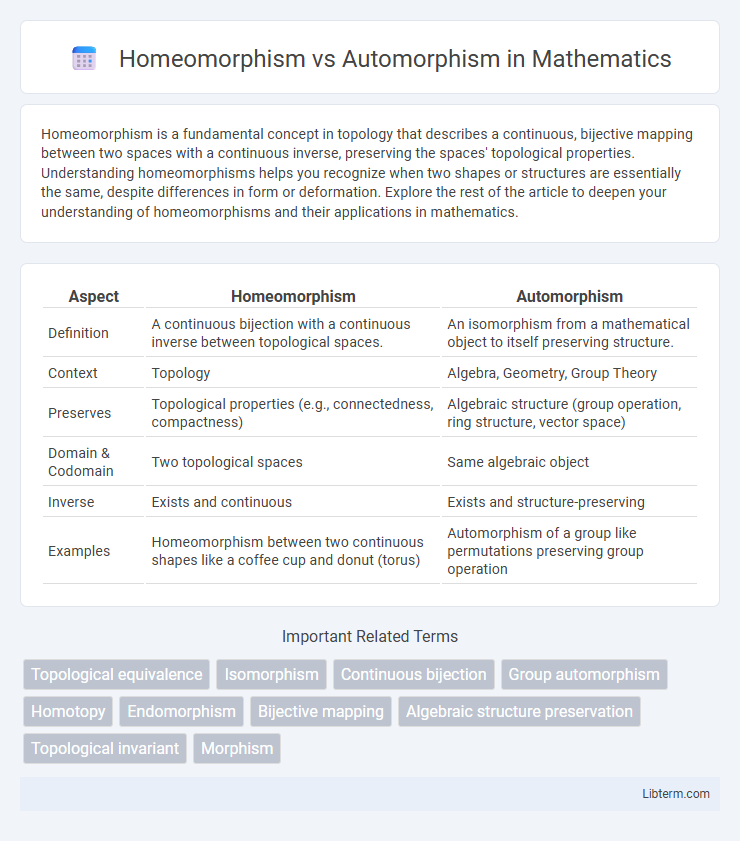Homeomorphism is a fundamental concept in topology that describes a continuous, bijective mapping between two spaces with a continuous inverse, preserving the spaces' topological properties. Understanding homeomorphisms helps you recognize when two shapes or structures are essentially the same, despite differences in form or deformation. Explore the rest of the article to deepen your understanding of homeomorphisms and their applications in mathematics.
Table of Comparison
| Aspect | Homeomorphism | Automorphism |
|---|---|---|
| Definition | A continuous bijection with a continuous inverse between topological spaces. | An isomorphism from a mathematical object to itself preserving structure. |
| Context | Topology | Algebra, Geometry, Group Theory |
| Preserves | Topological properties (e.g., connectedness, compactness) | Algebraic structure (group operation, ring structure, vector space) |
| Domain & Codomain | Two topological spaces | Same algebraic object |
| Inverse | Exists and continuous | Exists and structure-preserving |
| Examples | Homeomorphism between two continuous shapes like a coffee cup and donut (torus) | Automorphism of a group like permutations preserving group operation |
Introduction to Homeomorphism and Automorphism
Homeomorphism is a continuous, bijective function between topological spaces with a continuous inverse, preserving the spaces' topological properties. Automorphism is a structure-preserving isomorphism from a mathematical object to itself, often seen in algebraic structures like groups or graphs. Both concepts highlight symmetry, with homeomorphisms focusing on topological equivalence and automorphisms emphasizing internal structure invariance.
Defining Homeomorphism in Topology
Homeomorphism in topology is a continuous, bijective function between two topological spaces with a continuous inverse, preserving the spaces' topological properties. It represents an equivalence relation indicating that two spaces are topologically identical, meaning one can be deformed into the other without cutting or gluing. Unlike automorphisms, which are isomorphisms of a space onto itself preserving structure, homeomorphisms apply between possibly different spaces.
Understanding Automorphism in Mathematics
Automorphism in mathematics refers to a bijective map from a mathematical object to itself that preserves the object's structure, such as groups, rings, or topological spaces. Unlike homeomorphisms, which are isomorphisms in the category of topological spaces preserving continuity and its inverse, automorphisms apply to various algebraic structures maintaining operations and relations. Understanding automorphisms is crucial for studying symmetry and invariants within algebraic and geometric structures.
Core Similarities Between Homeomorphism and Automorphism
Homeomorphisms and automorphisms both represent structure-preserving maps within their respective mathematical contexts, with homeomorphisms preserving topological properties and automorphisms preserving algebraic structures. Each is an isomorphism, meaning it is bijective with a continuous inverse in topology and an invertible homomorphism in algebra. These mappings serve to identify equivalences within spaces or groups, enabling classification based on intrinsic properties rather than specific elements.
Key Differences: Topological vs Algebraic Structures
Homeomorphism is a continuous bijection between topological spaces that preserves topological properties such as connectedness and compactness, emphasizing the equivalence of spatial structures. Automorphism is an isomorphism within algebraic structures like groups or rings, preserving algebraic operations and internal symmetries. The key difference lies in homeomorphisms maintaining topological invariants, while automorphisms maintain algebraic relations and operations.
Mathematical Examples: Homeomorphism Explained
A homeomorphism is a continuous, bijective function between topological spaces with a continuous inverse, exemplified by the deformation of a coffee cup into a doughnut, both being topologically equivalent. Automorphisms are structure-preserving isomorphisms from a mathematical object to itself, such as a rotation of a square that maps the figure onto itself while preserving distances and angles. Homeomorphisms focus on topological equivalence, whereas automorphisms emphasize algebraic or geometric structure preservation within a single object.
Mathematical Examples: Automorphism Explained
Automorphisms are isomorphisms from a mathematical object to itself, preserving structure such as group operations or topological properties. For example, in group theory, an automorphism of a group G is a bijective homomorphism from G onto G, such as the map f(x) = gxg-1 for a fixed element g in G, known as an inner automorphism. In contrast, homeomorphisms are continuous bijections with continuous inverses between topological spaces, ensuring topological equivalence rather than algebraic structure preservation.
Importance in Mathematics and Related Fields
Homeomorphism characterizes topological equivalence by preserving spatial properties under continuous deformation, making it crucial in topology, geometry, and related fields for classifying spaces based on shape rather than rigid structure. Automorphism represents the symmetry within algebraic structures by being an isomorphism from an object to itself, essential in group theory, ring theory, and other areas to understand intrinsic structure-preserving transformations and invariants. Both concepts underpin modern mathematical frameworks, enabling deep insights into object classification, symmetry analysis, and structural rigidity across various mathematical disciplines.
Applications of Homeomorphism and Automorphism
Homeomorphisms and automorphisms play critical roles in topology and algebra, respectively. Homeomorphisms enable the analysis of topological spaces by preserving properties such as continuity and connectivity, making them essential in fields like geometric modeling, data analysis, and mathematical physics. Automorphisms facilitate the study of algebraic structures by preserving operations within groups, rings, or fields, proving indispensable in cryptography, coding theory, and the classification of algebraic objects.
Summary and Implications for Further Study
Homeomorphism and automorphism are fundamental concepts in topology and algebra, representing structure-preserving maps with distinct domains of application: homeomorphisms relate topological spaces preserving continuity and open sets, while automorphisms are isomorphisms of algebraic structures preserving operations. Understanding the nuances between these mappings facilitates deeper insights into space classification, symmetry, and invariants, enabling advanced analysis in manifold theory and group theory. Further study can explore the interaction between topological and algebraic structures, such as investigating automorphisms induced by homeomorphisms in algebraic topology and their impact on homotopy and homology groups.
Homeomorphism Infographic

 libterm.com
libterm.com